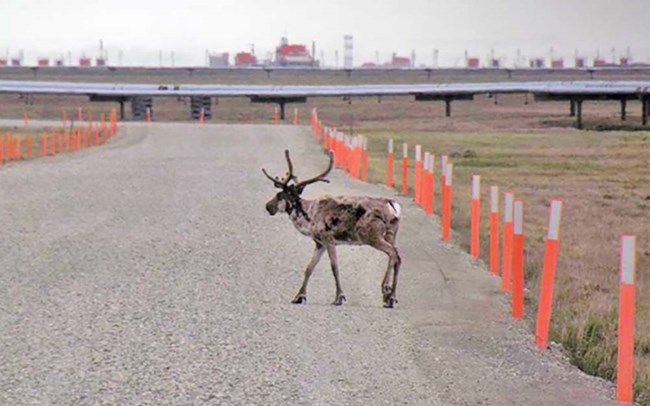Last updated: June 2, 2021
Article
New tools to better understand the potential impacts of Arctic development

USGS/John Severson
Two recent papers provide new tools for researchers and wildlife managers to better understand the potential impacts of development in the Arctic on a number of different species, including caribou. The first paper, Mapping potential effects of proposed roads on migratory connectivity for a highly mobile herbivore using circuit theory, looks at how the flow of caribou migrations might be affected by a proposed road system in northern Alaska. The flow of caribou was modeled after electrical currents, and different landscape variables were tested to see how much resistance they provided to migratory movements of caribou.
The second paper, Simulation modeling accounts for uncertainty while quantifying ecological effects of development alternatives, uses repeated simulation models to account for uncertainty in where future development may take place. Often when development is initially proposed, the total amount and location of infrastructure, such as roads, is not known. This method allows for this uncertainty and quantifies the range of potential impacts.
Both papers detail the expected impacts of proposed development. Land managers and others can use this information to make important decisions that balance the needs of wildlife, subsistence activities, and development. These papers were developed in collaboration with The Wilderness Society, Audubon Alaska, and the US Fish and Wildlife Service.
Mapping potential effects of proposed roads on migratory connectivity for a highly mobile herbivore using circuit theory
Abstract
Migration is common worldwide as species access spatiotemporally varying resources and avoid predators and parasites. However, long-distance migrations are increasingly imperiled due to development and habitat fragmentation. Improved understanding of migratory behavior has implications for conservation and management of migratory species, allowing identification and protection of seasonal ranges and migration corridors. We present a technique that applies circuit theory to predict future effects of development by analyzing season-specific resistance to movement from anthropogenic and natural environmental features across an entire migratory path. We demonstrate the utility of our approach by examining potential effects of a proposed road system on barren ground caribou (Rangifer tarandus granti) and subsistence hunters in northern Alaska. Resource selection functions revealed migratory selection by caribou. We tested five scenarios relating habitat selection to landscape resistance using Circuitscape and GPS telemetry data. To examine the effect of potential roads on connectivity of migrating animals and human hunters, we compared current flow values near communities in the presence of proposed roads. Caribou avoided dense vegetation, rugged terrain, major rivers, and existing roads in both spring and fall. A negative linear relationship between resource selection and landscape resistance was strongly supported for fall migration while spring migration featured a negative logarithmic relationship. Overall patterns of caribou connectivity remained similar in the presence of proposed roads, though reduced current flow was predicted for communities near the center of current migration areas. Such data can inform decisions to allow or disallow projects or to select among alternative development proposals and mitigation measures, though consideration of cumulative effects of development is needed. Our approach is flexible and can easily be adapted to other species, locations and development scenarios to expand understanding of movement behavior and to evaluate proposed developments. Such information is vital to inform policy decisions that balance new development, resource user needs, and preservation of ecosystem function.
Fullman, T. J., R. R. Wilson, K. Joly, D. D. Gustine, P. Leonard, and W. M. Loya. 2021. Mapping potential effects of proposed roads on migratory connectivity for a highly mobile herbivore using circuit theory. Ecological Applications 31(1): e2207.
Simulation modeling accounts for uncertainty while quantifying ecological effects of development alternatives
Abstract
Wildlife management often involves trade-offs between protecting species and allowing human activities and development. Ideally, these decisions are guided by scientific studies that quantify the impacts of proposed actions on the environment. However, critical information to assess impacts of proposed activities may be lacking, such as certainty in where actions will take place, which may hinder a robust impact assessment. To address this issue, we present the Development Impacts Analysis (DIA), which employs Monte Carlo simulation modeling to quantify the environmental consequences of proposed development scenarios, while accounting for uncertainty in the exact location of future development. We applied the DIA to five proposed oil leasing management scenarios under a revised management plan for the National Petroleum Reserve—Alaska. For each management scenario with differing levels of proposed development (“alternatives”), oil production pads and roads were randomly simulated in proportion to estimated undiscovered oil and following alternative-specific restrictions. We assessed habitat displacement for two caribou (Rangifer tarandus) herds, eight shorebird species, and black brant (Branta bernicla) based on reported responses to development, repeating the process 100 times for each alternative. Some habitat loss was reported for each proposed alternative, but the amount of impact varied by alternative and species. One caribou herd and most bird species indicated greatest effects in the alternative with the least restrictions on development and lesser impacts under more protective alternatives. Our results emphasized the importance of considering spatial variation in development effects and species-specific differences when evaluating management proposals. The DIA quantified potential impacts on a suite of species under proposed management alternatives, while accounting for uncertainty in where development will occur and providing confidence intervals on estimated impacts. This illustrates that uncertainty need not preclude management decisions about establishment of broad land use restrictions prior to submission of project-level proposals but can instead be explicitly incorporated into decision making. While no single management approach will likely benefit all species, use of tools such as the DIA allows managers to quantify trade-offs among species and pursue approaches that balance the needs of various taxa and other management objectives.
Fullman, T. J., B. K. Sullender, M. D. Cameron, and K. Joly. 2021. Simulation modeling accounts for uncertainty while quantifying ecological effects of development alternatives. Ecosphere 12(5): e03530.
